Financial Analysis and Audit: Planning, Controls, and Assertions
VerifiedAdded on 2020/05/28
|13
|2820
|64
Homework Assignment
AI Summary
This student assignment delves into financial analysis, focusing on planning, risk assessment, and internal controls within a company. The assignment examines financial statements, including profit margins, current ratios, and debt levels, to predict future financial performance. It identifies key accounts at risk of material misstatement, such as costs, inventory, and debts, and explores the relevant assertions for each. The assessment covers ratio analysis, management reports, and internal controls. The second part analyzes internal control activities within sales and receivables, including segregation of duties, sales order preparation, and ledger posting. It identifies weaknesses, such as manual processes and credit-based sales, and assesses the associated risks of misstatement in sales and accounts receivable. The assignment also provides tests of controls to verify the effectiveness of implemented internal controls. This assignment offers a comprehensive overview of financial analysis and internal control processes.
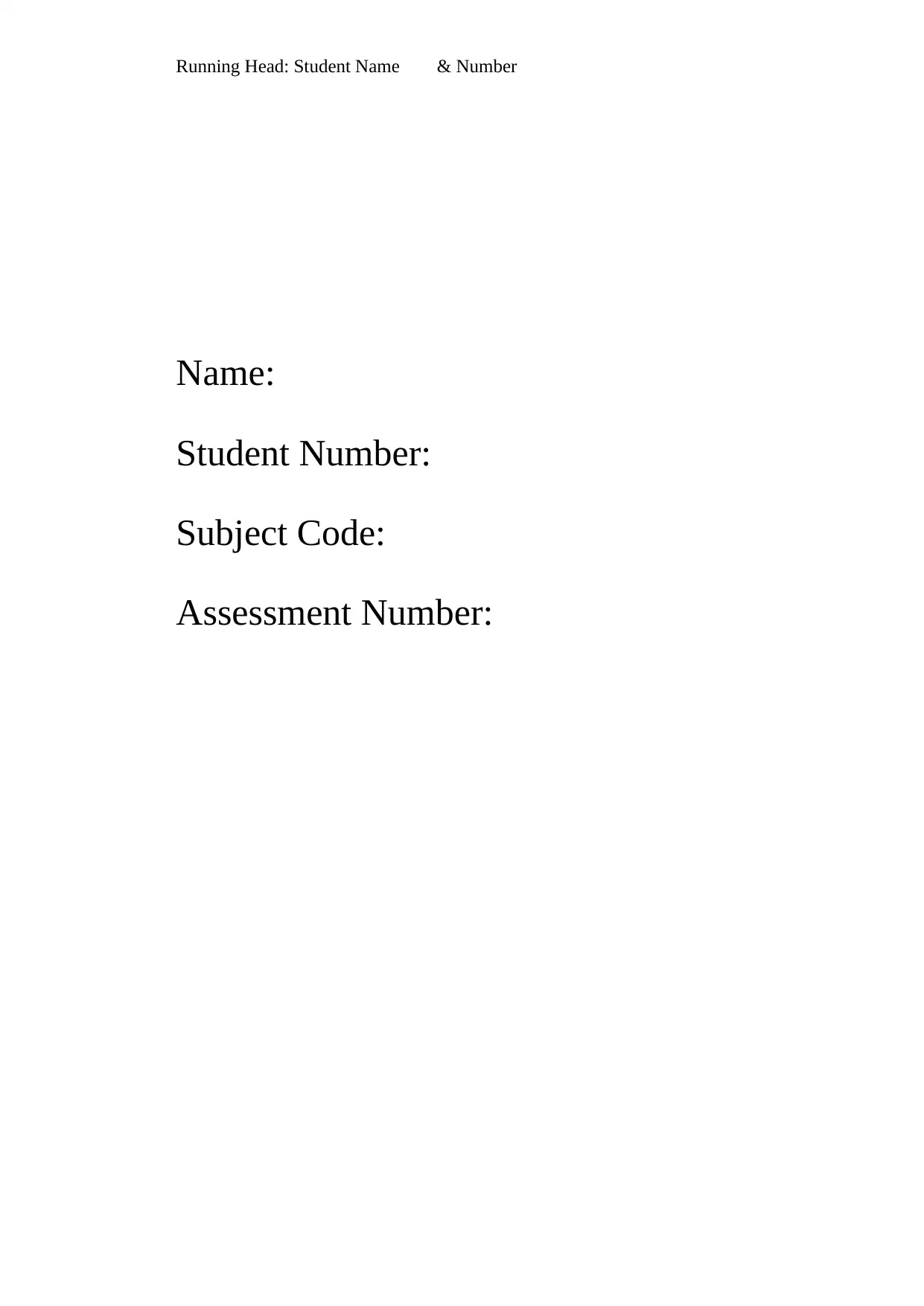
Running Head: Student Name & Number
Name:
Student Number:
Subject Code:
Assessment Number:
Name:
Student Number:
Subject Code:
Assessment Number:
Paraphrase This Document
Need a fresh take? Get an instant paraphrase of this document with our AI Paraphraser
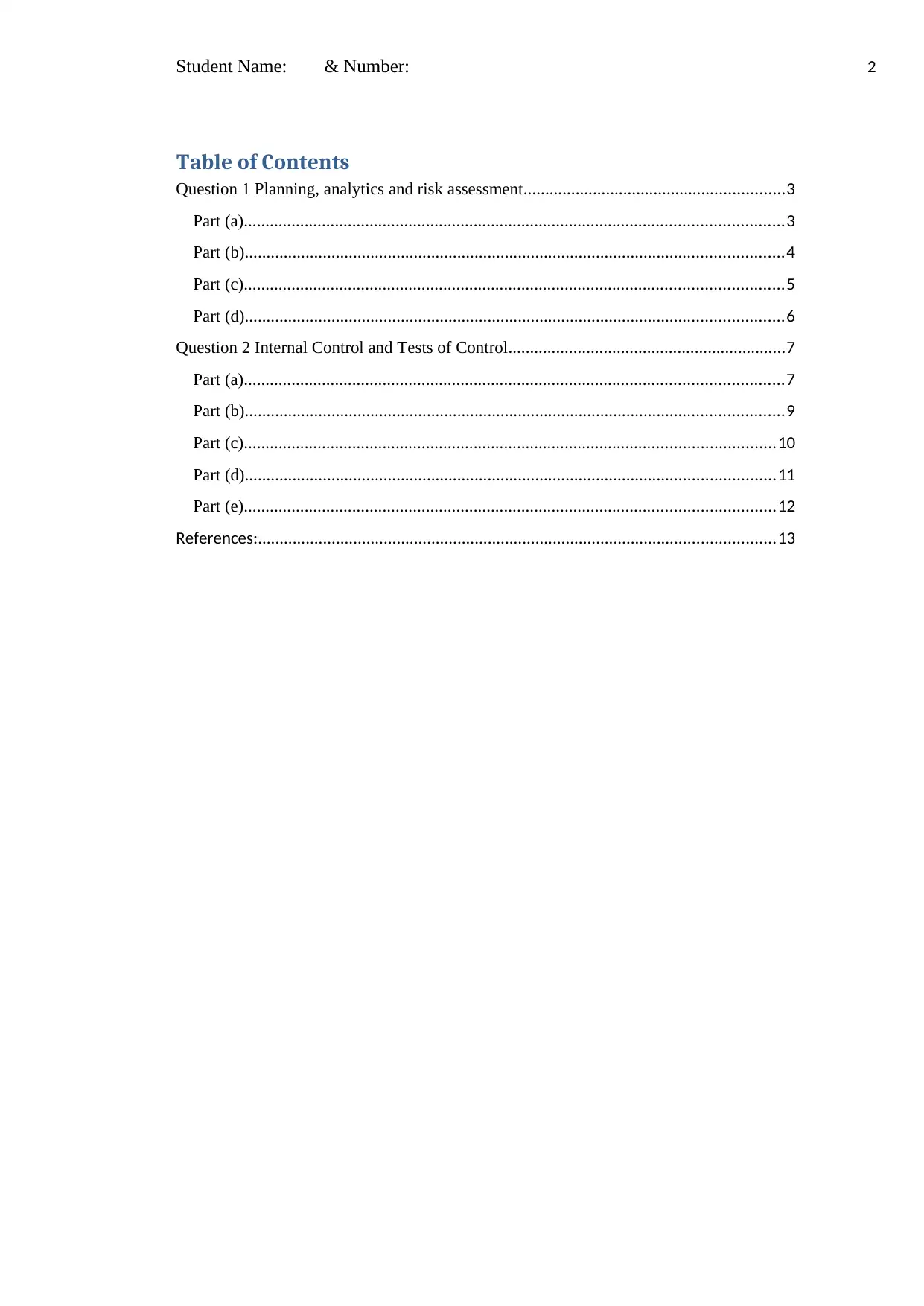
Student Name: & Number: 2
Table of Contents
Question 1 Planning, analytics and risk assessment............................................................3
Part (a)............................................................................................................................3
Part (b)............................................................................................................................4
Part (c)............................................................................................................................5
Part (d)............................................................................................................................6
Question 2 Internal Control and Tests of Control................................................................7
Part (a)............................................................................................................................7
Part (b)............................................................................................................................9
Part (c)..........................................................................................................................10
Part (d)..........................................................................................................................11
Part (e)..........................................................................................................................12
References:.......................................................................................................................13
Table of Contents
Question 1 Planning, analytics and risk assessment............................................................3
Part (a)............................................................................................................................3
Part (b)............................................................................................................................4
Part (c)............................................................................................................................5
Part (d)............................................................................................................................6
Question 2 Internal Control and Tests of Control................................................................7
Part (a)............................................................................................................................7
Part (b)............................................................................................................................9
Part (c)..........................................................................................................................10
Part (d)..........................................................................................................................11
Part (e)..........................................................................................................................12
References:.......................................................................................................................13
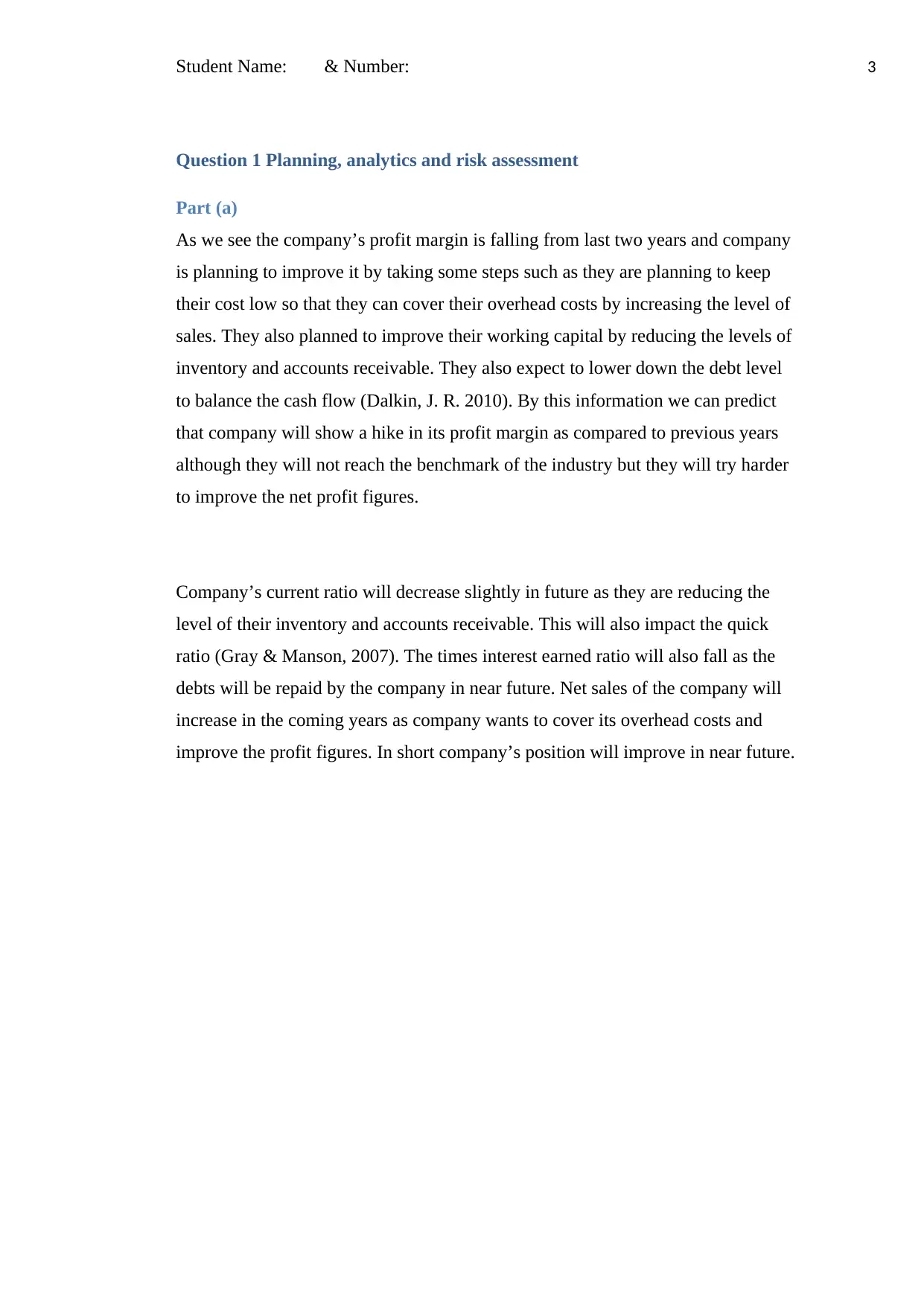
Student Name: & Number: 3
Question 1 Planning, analytics and risk assessment
Part (a)
As we see the company’s profit margin is falling from last two years and company
is planning to improve it by taking some steps such as they are planning to keep
their cost low so that they can cover their overhead costs by increasing the level of
sales. They also planned to improve their working capital by reducing the levels of
inventory and accounts receivable. They also expect to lower down the debt level
to balance the cash flow (Dalkin, J. R. 2010). By this information we can predict
that company will show a hike in its profit margin as compared to previous years
although they will not reach the benchmark of the industry but they will try harder
to improve the net profit figures.
Company’s current ratio will decrease slightly in future as they are reducing the
level of their inventory and accounts receivable. This will also impact the quick
ratio (Gray & Manson, 2007). The times interest earned ratio will also fall as the
debts will be repaid by the company in near future. Net sales of the company will
increase in the coming years as company wants to cover its overhead costs and
improve the profit figures. In short company’s position will improve in near future.
Question 1 Planning, analytics and risk assessment
Part (a)
As we see the company’s profit margin is falling from last two years and company
is planning to improve it by taking some steps such as they are planning to keep
their cost low so that they can cover their overhead costs by increasing the level of
sales. They also planned to improve their working capital by reducing the levels of
inventory and accounts receivable. They also expect to lower down the debt level
to balance the cash flow (Dalkin, J. R. 2010). By this information we can predict
that company will show a hike in its profit margin as compared to previous years
although they will not reach the benchmark of the industry but they will try harder
to improve the net profit figures.
Company’s current ratio will decrease slightly in future as they are reducing the
level of their inventory and accounts receivable. This will also impact the quick
ratio (Gray & Manson, 2007). The times interest earned ratio will also fall as the
debts will be repaid by the company in near future. Net sales of the company will
increase in the coming years as company wants to cover its overhead costs and
improve the profit figures. In short company’s position will improve in near future.
⊘ This is a preview!⊘
Do you want full access?
Subscribe today to unlock all pages.

Trusted by 1+ million students worldwide
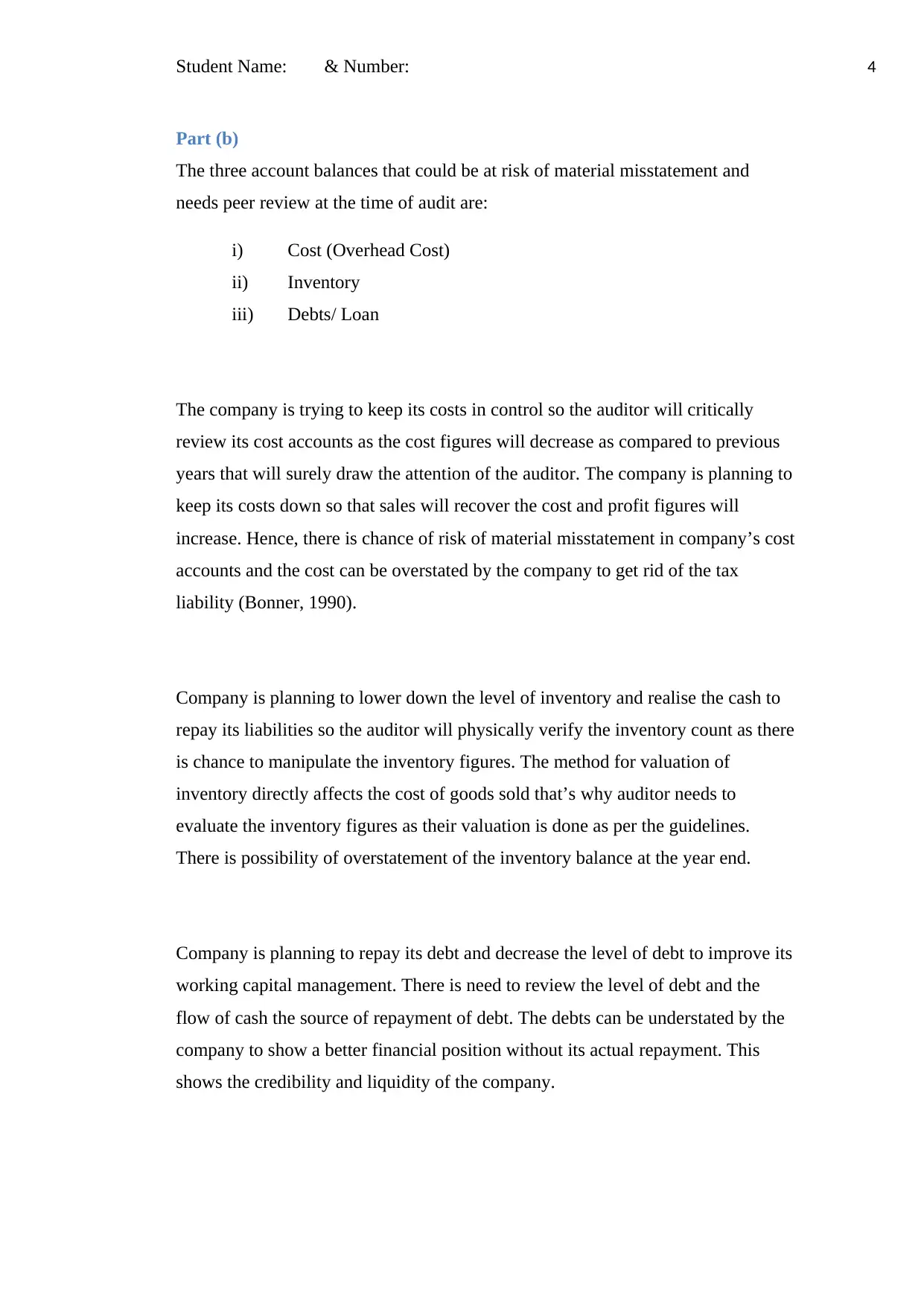
Student Name: & Number: 4
Part (b)
The three account balances that could be at risk of material misstatement and
needs peer review at the time of audit are:
i) Cost (Overhead Cost)
ii) Inventory
iii) Debts/ Loan
The company is trying to keep its costs in control so the auditor will critically
review its cost accounts as the cost figures will decrease as compared to previous
years that will surely draw the attention of the auditor. The company is planning to
keep its costs down so that sales will recover the cost and profit figures will
increase. Hence, there is chance of risk of material misstatement in company’s cost
accounts and the cost can be overstated by the company to get rid of the tax
liability (Bonner, 1990).
Company is planning to lower down the level of inventory and realise the cash to
repay its liabilities so the auditor will physically verify the inventory count as there
is chance to manipulate the inventory figures. The method for valuation of
inventory directly affects the cost of goods sold that’s why auditor needs to
evaluate the inventory figures as their valuation is done as per the guidelines.
There is possibility of overstatement of the inventory balance at the year end.
Company is planning to repay its debt and decrease the level of debt to improve its
working capital management. There is need to review the level of debt and the
flow of cash the source of repayment of debt. The debts can be understated by the
company to show a better financial position without its actual repayment. This
shows the credibility and liquidity of the company.
Part (b)
The three account balances that could be at risk of material misstatement and
needs peer review at the time of audit are:
i) Cost (Overhead Cost)
ii) Inventory
iii) Debts/ Loan
The company is trying to keep its costs in control so the auditor will critically
review its cost accounts as the cost figures will decrease as compared to previous
years that will surely draw the attention of the auditor. The company is planning to
keep its costs down so that sales will recover the cost and profit figures will
increase. Hence, there is chance of risk of material misstatement in company’s cost
accounts and the cost can be overstated by the company to get rid of the tax
liability (Bonner, 1990).
Company is planning to lower down the level of inventory and realise the cash to
repay its liabilities so the auditor will physically verify the inventory count as there
is chance to manipulate the inventory figures. The method for valuation of
inventory directly affects the cost of goods sold that’s why auditor needs to
evaluate the inventory figures as their valuation is done as per the guidelines.
There is possibility of overstatement of the inventory balance at the year end.
Company is planning to repay its debt and decrease the level of debt to improve its
working capital management. There is need to review the level of debt and the
flow of cash the source of repayment of debt. The debts can be understated by the
company to show a better financial position without its actual repayment. This
shows the credibility and liquidity of the company.
Paraphrase This Document
Need a fresh take? Get an instant paraphrase of this document with our AI Paraphraser
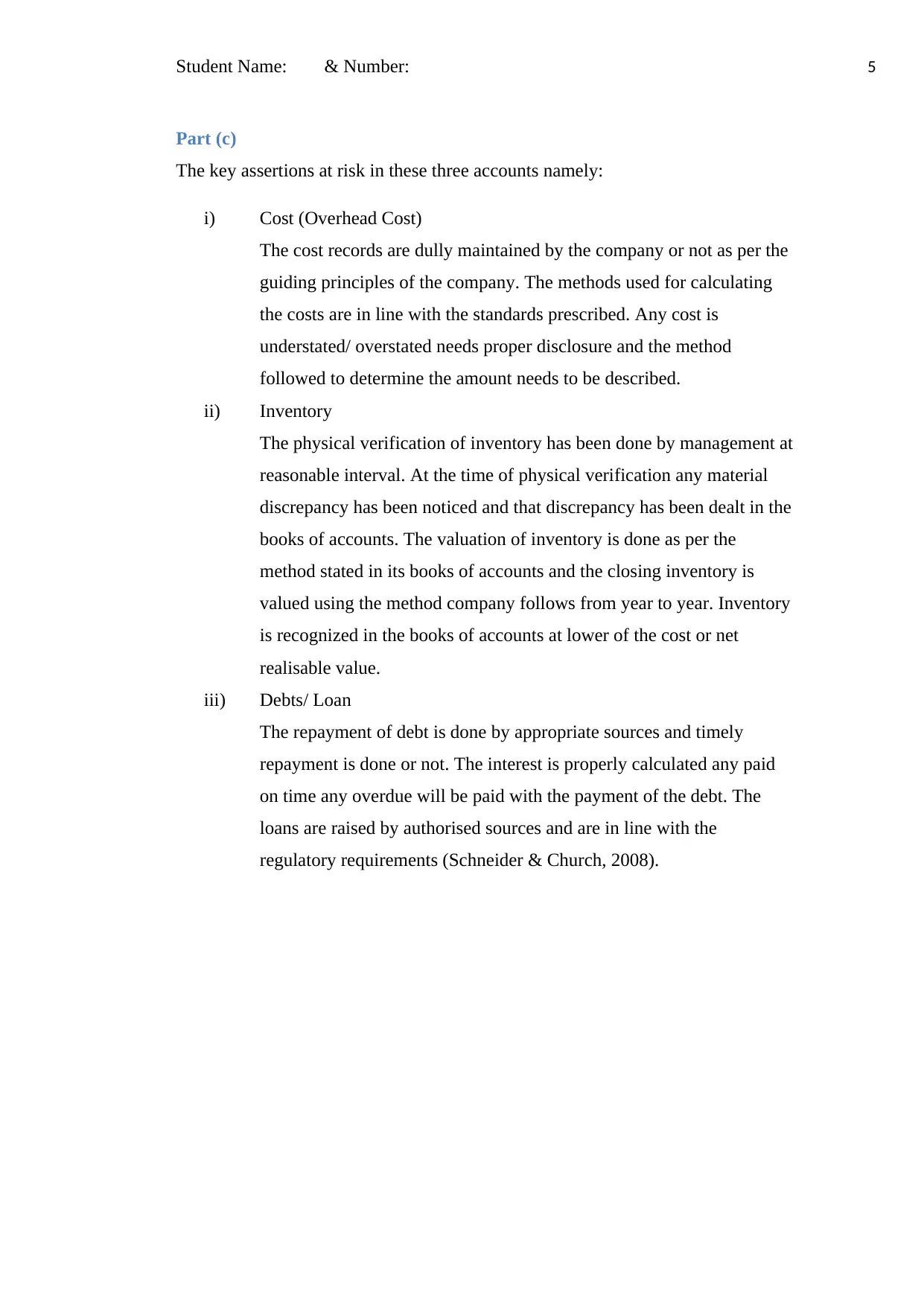
Student Name: & Number: 5
Part (c)
The key assertions at risk in these three accounts namely:
i) Cost (Overhead Cost)
The cost records are dully maintained by the company or not as per the
guiding principles of the company. The methods used for calculating
the costs are in line with the standards prescribed. Any cost is
understated/ overstated needs proper disclosure and the method
followed to determine the amount needs to be described.
ii) Inventory
The physical verification of inventory has been done by management at
reasonable interval. At the time of physical verification any material
discrepancy has been noticed and that discrepancy has been dealt in the
books of accounts. The valuation of inventory is done as per the
method stated in its books of accounts and the closing inventory is
valued using the method company follows from year to year. Inventory
is recognized in the books of accounts at lower of the cost or net
realisable value.
iii) Debts/ Loan
The repayment of debt is done by appropriate sources and timely
repayment is done or not. The interest is properly calculated any paid
on time any overdue will be paid with the payment of the debt. The
loans are raised by authorised sources and are in line with the
regulatory requirements (Schneider & Church, 2008).
Part (c)
The key assertions at risk in these three accounts namely:
i) Cost (Overhead Cost)
The cost records are dully maintained by the company or not as per the
guiding principles of the company. The methods used for calculating
the costs are in line with the standards prescribed. Any cost is
understated/ overstated needs proper disclosure and the method
followed to determine the amount needs to be described.
ii) Inventory
The physical verification of inventory has been done by management at
reasonable interval. At the time of physical verification any material
discrepancy has been noticed and that discrepancy has been dealt in the
books of accounts. The valuation of inventory is done as per the
method stated in its books of accounts and the closing inventory is
valued using the method company follows from year to year. Inventory
is recognized in the books of accounts at lower of the cost or net
realisable value.
iii) Debts/ Loan
The repayment of debt is done by appropriate sources and timely
repayment is done or not. The interest is properly calculated any paid
on time any overdue will be paid with the payment of the debt. The
loans are raised by authorised sources and are in line with the
regulatory requirements (Schneider & Church, 2008).
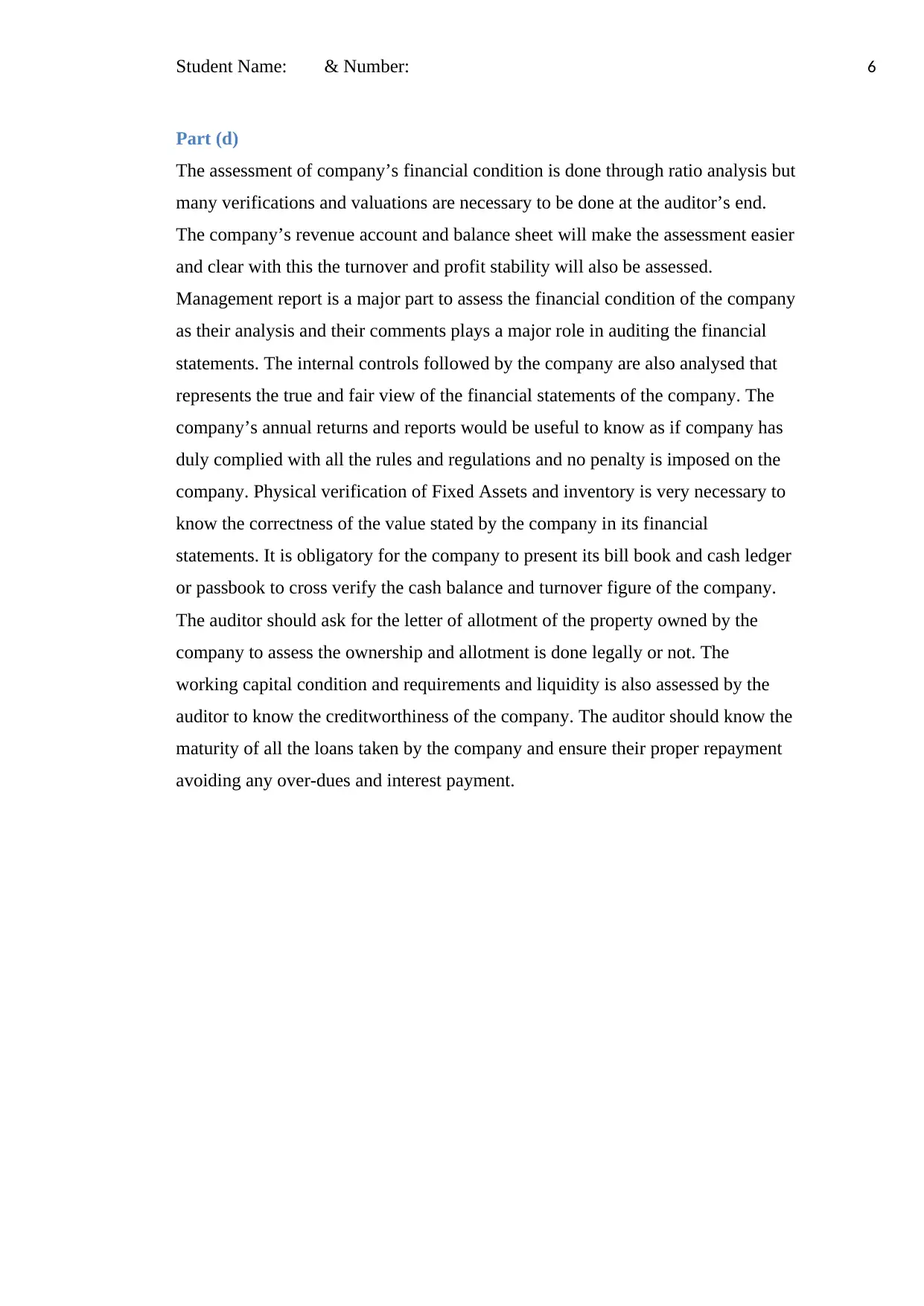
Student Name: & Number: 6
Part (d)
The assessment of company’s financial condition is done through ratio analysis but
many verifications and valuations are necessary to be done at the auditor’s end.
The company’s revenue account and balance sheet will make the assessment easier
and clear with this the turnover and profit stability will also be assessed.
Management report is a major part to assess the financial condition of the company
as their analysis and their comments plays a major role in auditing the financial
statements. The internal controls followed by the company are also analysed that
represents the true and fair view of the financial statements of the company. The
company’s annual returns and reports would be useful to know as if company has
duly complied with all the rules and regulations and no penalty is imposed on the
company. Physical verification of Fixed Assets and inventory is very necessary to
know the correctness of the value stated by the company in its financial
statements. It is obligatory for the company to present its bill book and cash ledger
or passbook to cross verify the cash balance and turnover figure of the company.
The auditor should ask for the letter of allotment of the property owned by the
company to assess the ownership and allotment is done legally or not. The
working capital condition and requirements and liquidity is also assessed by the
auditor to know the creditworthiness of the company. The auditor should know the
maturity of all the loans taken by the company and ensure their proper repayment
avoiding any over-dues and interest payment.
Part (d)
The assessment of company’s financial condition is done through ratio analysis but
many verifications and valuations are necessary to be done at the auditor’s end.
The company’s revenue account and balance sheet will make the assessment easier
and clear with this the turnover and profit stability will also be assessed.
Management report is a major part to assess the financial condition of the company
as their analysis and their comments plays a major role in auditing the financial
statements. The internal controls followed by the company are also analysed that
represents the true and fair view of the financial statements of the company. The
company’s annual returns and reports would be useful to know as if company has
duly complied with all the rules and regulations and no penalty is imposed on the
company. Physical verification of Fixed Assets and inventory is very necessary to
know the correctness of the value stated by the company in its financial
statements. It is obligatory for the company to present its bill book and cash ledger
or passbook to cross verify the cash balance and turnover figure of the company.
The auditor should ask for the letter of allotment of the property owned by the
company to assess the ownership and allotment is done legally or not. The
working capital condition and requirements and liquidity is also assessed by the
auditor to know the creditworthiness of the company. The auditor should know the
maturity of all the loans taken by the company and ensure their proper repayment
avoiding any over-dues and interest payment.
⊘ This is a preview!⊘
Do you want full access?
Subscribe today to unlock all pages.

Trusted by 1+ million students worldwide
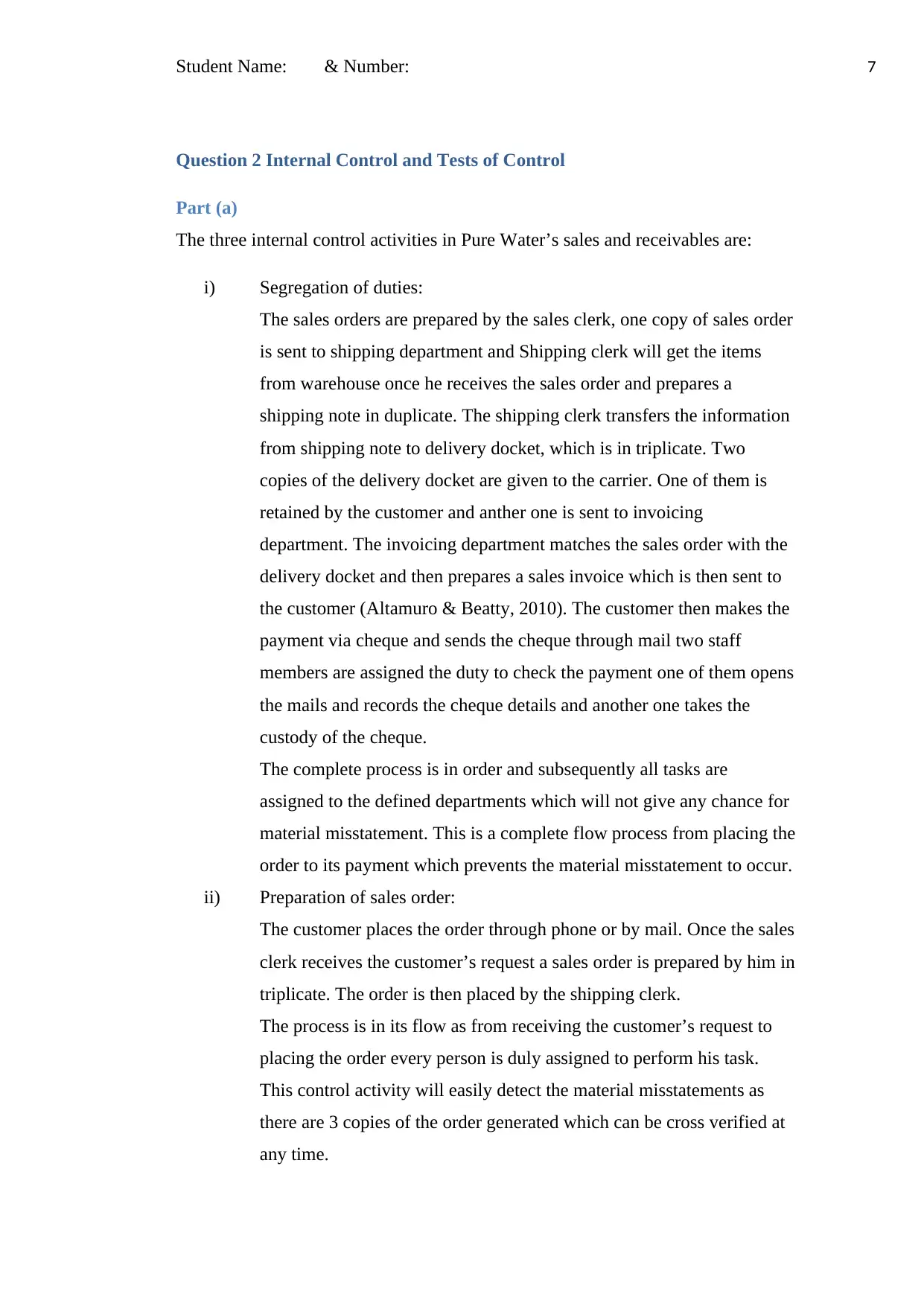
Student Name: & Number: 7
Question 2 Internal Control and Tests of Control
Part (a)
The three internal control activities in Pure Water’s sales and receivables are:
i) Segregation of duties:
The sales orders are prepared by the sales clerk, one copy of sales order
is sent to shipping department and Shipping clerk will get the items
from warehouse once he receives the sales order and prepares a
shipping note in duplicate. The shipping clerk transfers the information
from shipping note to delivery docket, which is in triplicate. Two
copies of the delivery docket are given to the carrier. One of them is
retained by the customer and anther one is sent to invoicing
department. The invoicing department matches the sales order with the
delivery docket and then prepares a sales invoice which is then sent to
the customer (Altamuro & Beatty, 2010). The customer then makes the
payment via cheque and sends the cheque through mail two staff
members are assigned the duty to check the payment one of them opens
the mails and records the cheque details and another one takes the
custody of the cheque.
The complete process is in order and subsequently all tasks are
assigned to the defined departments which will not give any chance for
material misstatement. This is a complete flow process from placing the
order to its payment which prevents the material misstatement to occur.
ii) Preparation of sales order:
The customer places the order through phone or by mail. Once the sales
clerk receives the customer’s request a sales order is prepared by him in
triplicate. The order is then placed by the shipping clerk.
The process is in its flow as from receiving the customer’s request to
placing the order every person is duly assigned to perform his task.
This control activity will easily detect the material misstatements as
there are 3 copies of the order generated which can be cross verified at
any time.
Question 2 Internal Control and Tests of Control
Part (a)
The three internal control activities in Pure Water’s sales and receivables are:
i) Segregation of duties:
The sales orders are prepared by the sales clerk, one copy of sales order
is sent to shipping department and Shipping clerk will get the items
from warehouse once he receives the sales order and prepares a
shipping note in duplicate. The shipping clerk transfers the information
from shipping note to delivery docket, which is in triplicate. Two
copies of the delivery docket are given to the carrier. One of them is
retained by the customer and anther one is sent to invoicing
department. The invoicing department matches the sales order with the
delivery docket and then prepares a sales invoice which is then sent to
the customer (Altamuro & Beatty, 2010). The customer then makes the
payment via cheque and sends the cheque through mail two staff
members are assigned the duty to check the payment one of them opens
the mails and records the cheque details and another one takes the
custody of the cheque.
The complete process is in order and subsequently all tasks are
assigned to the defined departments which will not give any chance for
material misstatement. This is a complete flow process from placing the
order to its payment which prevents the material misstatement to occur.
ii) Preparation of sales order:
The customer places the order through phone or by mail. Once the sales
clerk receives the customer’s request a sales order is prepared by him in
triplicate. The order is then placed by the shipping clerk.
The process is in its flow as from receiving the customer’s request to
placing the order every person is duly assigned to perform his task.
This control activity will easily detect the material misstatements as
there are 3 copies of the order generated which can be cross verified at
any time.
Paraphrase This Document
Need a fresh take? Get an instant paraphrase of this document with our AI Paraphraser
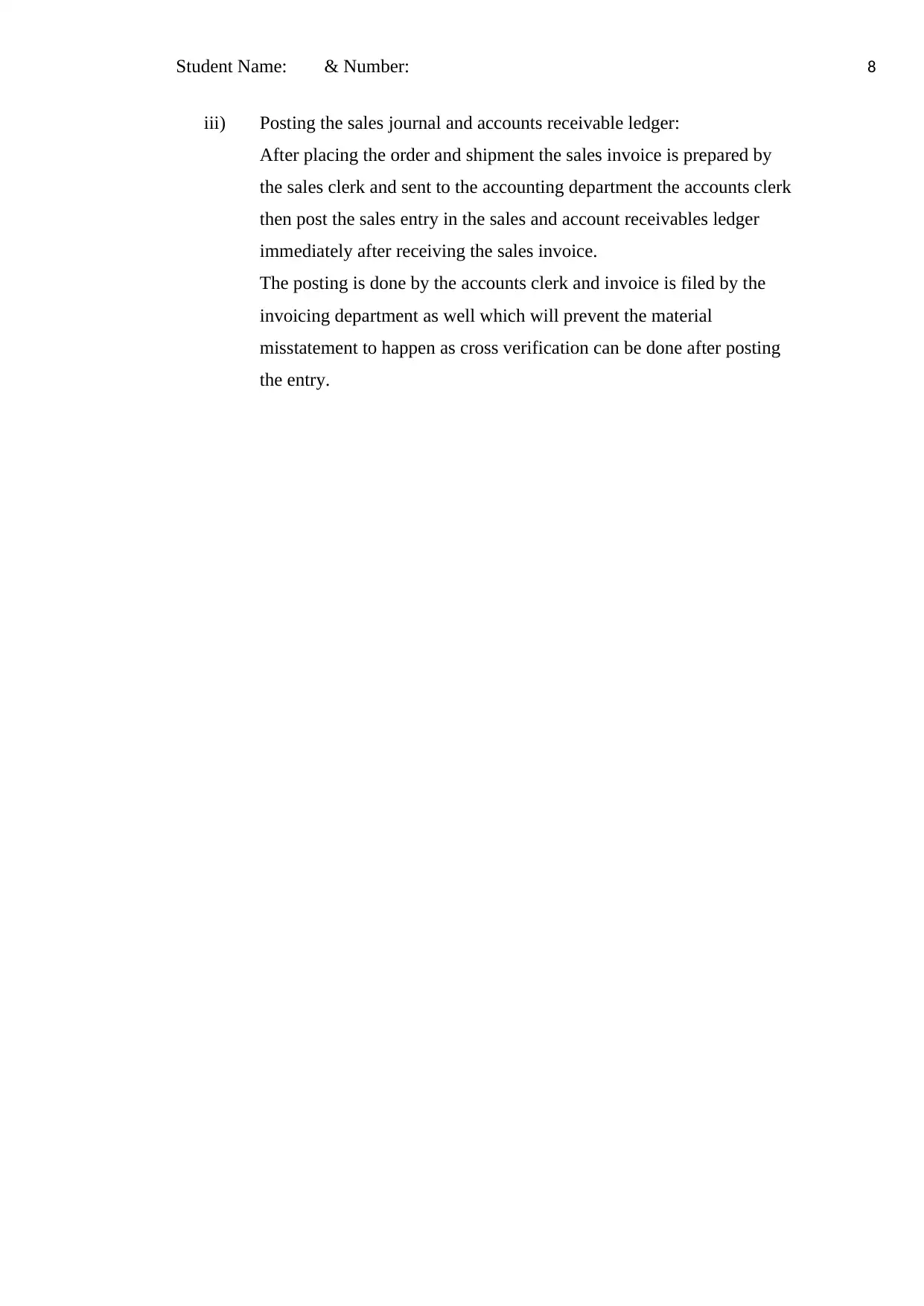
Student Name: & Number: 8
iii) Posting the sales journal and accounts receivable ledger:
After placing the order and shipment the sales invoice is prepared by
the sales clerk and sent to the accounting department the accounts clerk
then post the sales entry in the sales and account receivables ledger
immediately after receiving the sales invoice.
The posting is done by the accounts clerk and invoice is filed by the
invoicing department as well which will prevent the material
misstatement to happen as cross verification can be done after posting
the entry.
iii) Posting the sales journal and accounts receivable ledger:
After placing the order and shipment the sales invoice is prepared by
the sales clerk and sent to the accounting department the accounts clerk
then post the sales entry in the sales and account receivables ledger
immediately after receiving the sales invoice.
The posting is done by the accounts clerk and invoice is filed by the
invoicing department as well which will prevent the material
misstatement to happen as cross verification can be done after posting
the entry.
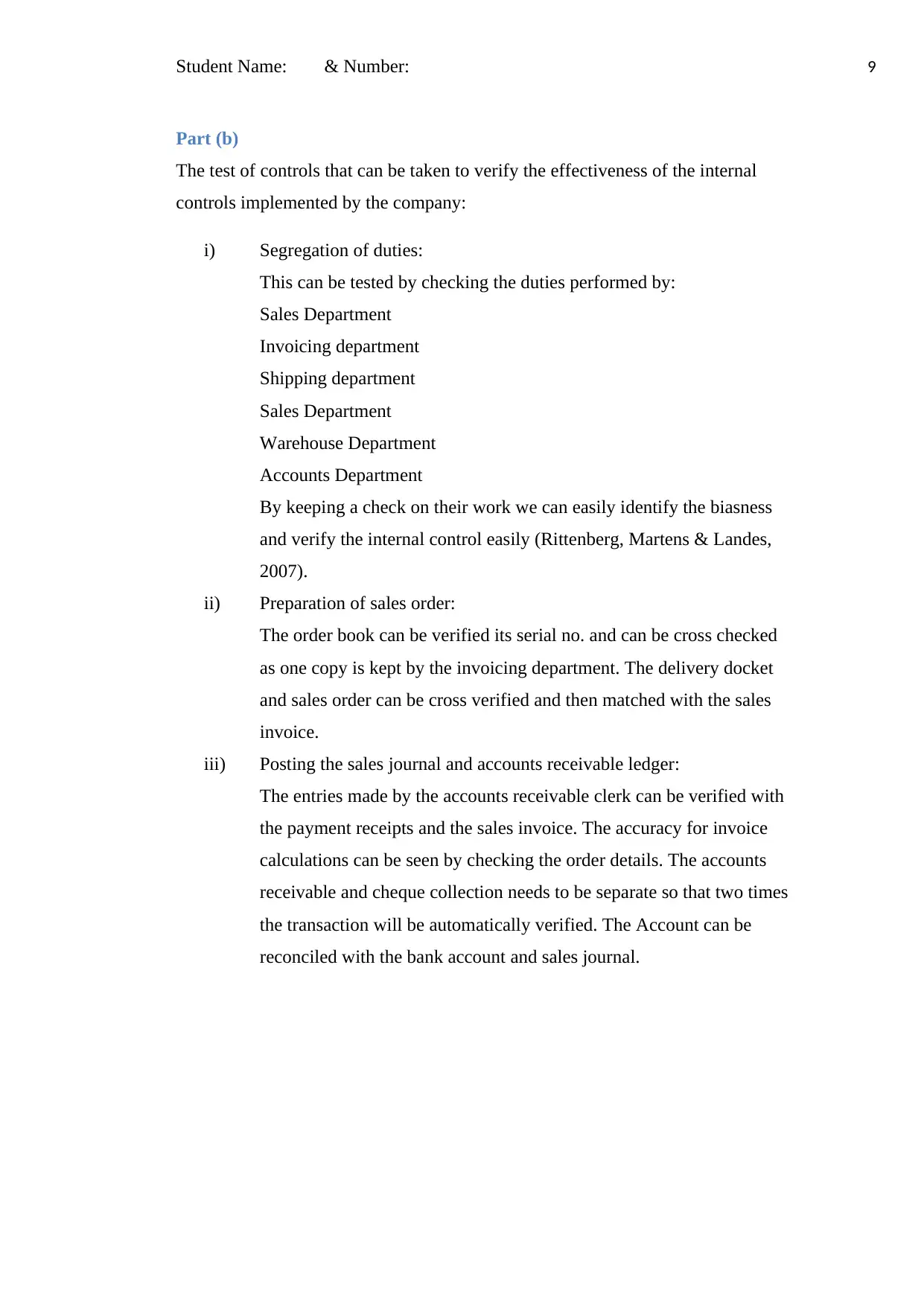
Student Name: & Number: 9
Part (b)
The test of controls that can be taken to verify the effectiveness of the internal
controls implemented by the company:
i) Segregation of duties:
This can be tested by checking the duties performed by:
Sales Department
Invoicing department
Shipping department
Sales Department
Warehouse Department
Accounts Department
By keeping a check on their work we can easily identify the biasness
and verify the internal control easily (Rittenberg, Martens & Landes,
2007).
ii) Preparation of sales order:
The order book can be verified its serial no. and can be cross checked
as one copy is kept by the invoicing department. The delivery docket
and sales order can be cross verified and then matched with the sales
invoice.
iii) Posting the sales journal and accounts receivable ledger:
The entries made by the accounts receivable clerk can be verified with
the payment receipts and the sales invoice. The accuracy for invoice
calculations can be seen by checking the order details. The accounts
receivable and cheque collection needs to be separate so that two times
the transaction will be automatically verified. The Account can be
reconciled with the bank account and sales journal.
Part (b)
The test of controls that can be taken to verify the effectiveness of the internal
controls implemented by the company:
i) Segregation of duties:
This can be tested by checking the duties performed by:
Sales Department
Invoicing department
Shipping department
Sales Department
Warehouse Department
Accounts Department
By keeping a check on their work we can easily identify the biasness
and verify the internal control easily (Rittenberg, Martens & Landes,
2007).
ii) Preparation of sales order:
The order book can be verified its serial no. and can be cross checked
as one copy is kept by the invoicing department. The delivery docket
and sales order can be cross verified and then matched with the sales
invoice.
iii) Posting the sales journal and accounts receivable ledger:
The entries made by the accounts receivable clerk can be verified with
the payment receipts and the sales invoice. The accuracy for invoice
calculations can be seen by checking the order details. The accounts
receivable and cheque collection needs to be separate so that two times
the transaction will be automatically verified. The Account can be
reconciled with the bank account and sales journal.
⊘ This is a preview!⊘
Do you want full access?
Subscribe today to unlock all pages.

Trusted by 1+ million students worldwide
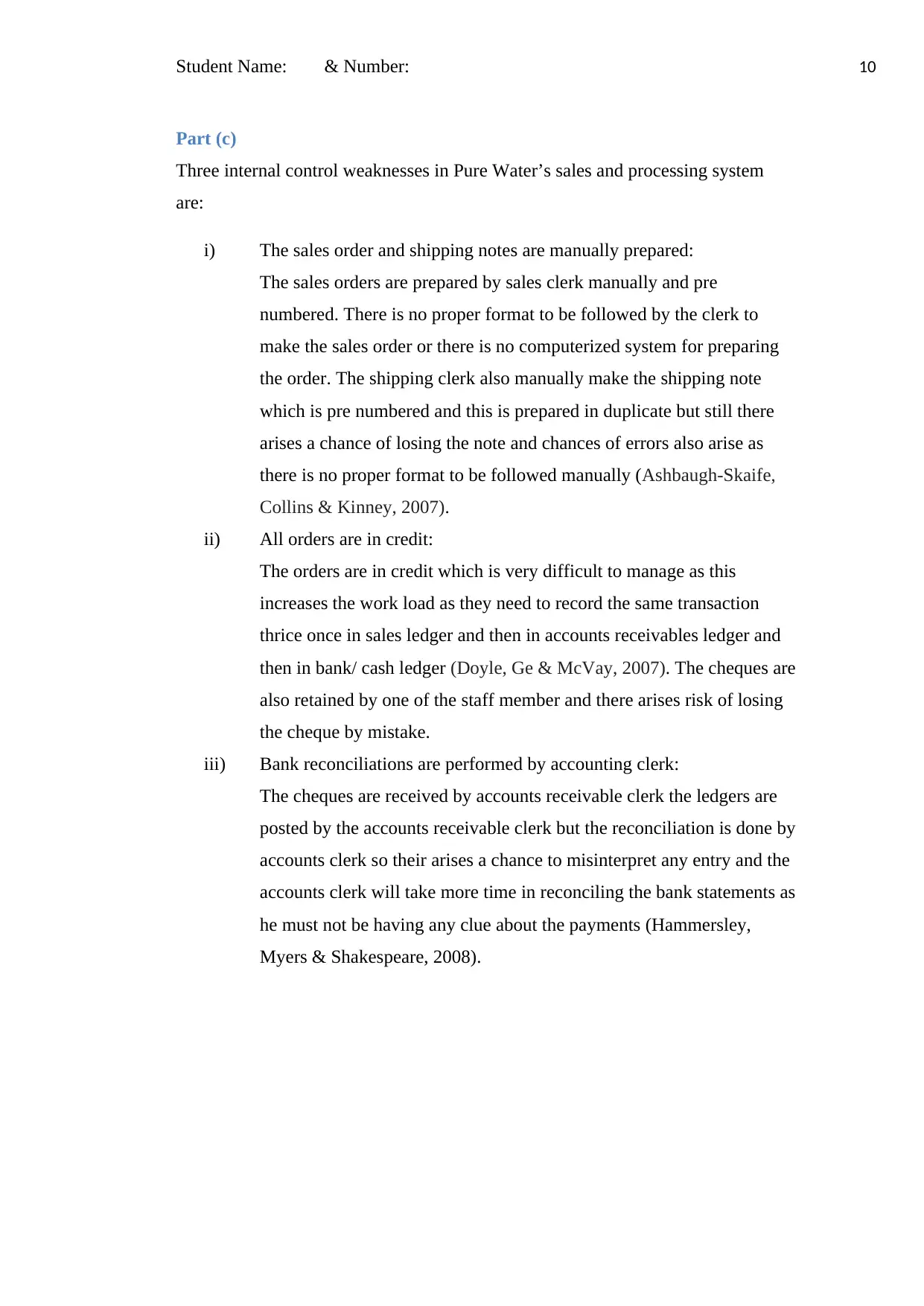
Student Name: & Number: 10
Part (c)
Three internal control weaknesses in Pure Water’s sales and processing system
are:
i) The sales order and shipping notes are manually prepared:
The sales orders are prepared by sales clerk manually and pre
numbered. There is no proper format to be followed by the clerk to
make the sales order or there is no computerized system for preparing
the order. The shipping clerk also manually make the shipping note
which is pre numbered and this is prepared in duplicate but still there
arises a chance of losing the note and chances of errors also arise as
there is no proper format to be followed manually (Ashbaugh-Skaife,
Collins & Kinney, 2007).
ii) All orders are in credit:
The orders are in credit which is very difficult to manage as this
increases the work load as they need to record the same transaction
thrice once in sales ledger and then in accounts receivables ledger and
then in bank/ cash ledger (Doyle, Ge & McVay, 2007). The cheques are
also retained by one of the staff member and there arises risk of losing
the cheque by mistake.
iii) Bank reconciliations are performed by accounting clerk:
The cheques are received by accounts receivable clerk the ledgers are
posted by the accounts receivable clerk but the reconciliation is done by
accounts clerk so their arises a chance to misinterpret any entry and the
accounts clerk will take more time in reconciling the bank statements as
he must not be having any clue about the payments (Hammersley,
Myers & Shakespeare, 2008).
Part (c)
Three internal control weaknesses in Pure Water’s sales and processing system
are:
i) The sales order and shipping notes are manually prepared:
The sales orders are prepared by sales clerk manually and pre
numbered. There is no proper format to be followed by the clerk to
make the sales order or there is no computerized system for preparing
the order. The shipping clerk also manually make the shipping note
which is pre numbered and this is prepared in duplicate but still there
arises a chance of losing the note and chances of errors also arise as
there is no proper format to be followed manually (Ashbaugh-Skaife,
Collins & Kinney, 2007).
ii) All orders are in credit:
The orders are in credit which is very difficult to manage as this
increases the work load as they need to record the same transaction
thrice once in sales ledger and then in accounts receivables ledger and
then in bank/ cash ledger (Doyle, Ge & McVay, 2007). The cheques are
also retained by one of the staff member and there arises risk of losing
the cheque by mistake.
iii) Bank reconciliations are performed by accounting clerk:
The cheques are received by accounts receivable clerk the ledgers are
posted by the accounts receivable clerk but the reconciliation is done by
accounts clerk so their arises a chance to misinterpret any entry and the
accounts clerk will take more time in reconciling the bank statements as
he must not be having any clue about the payments (Hammersley,
Myers & Shakespeare, 2008).
Paraphrase This Document
Need a fresh take? Get an instant paraphrase of this document with our AI Paraphraser
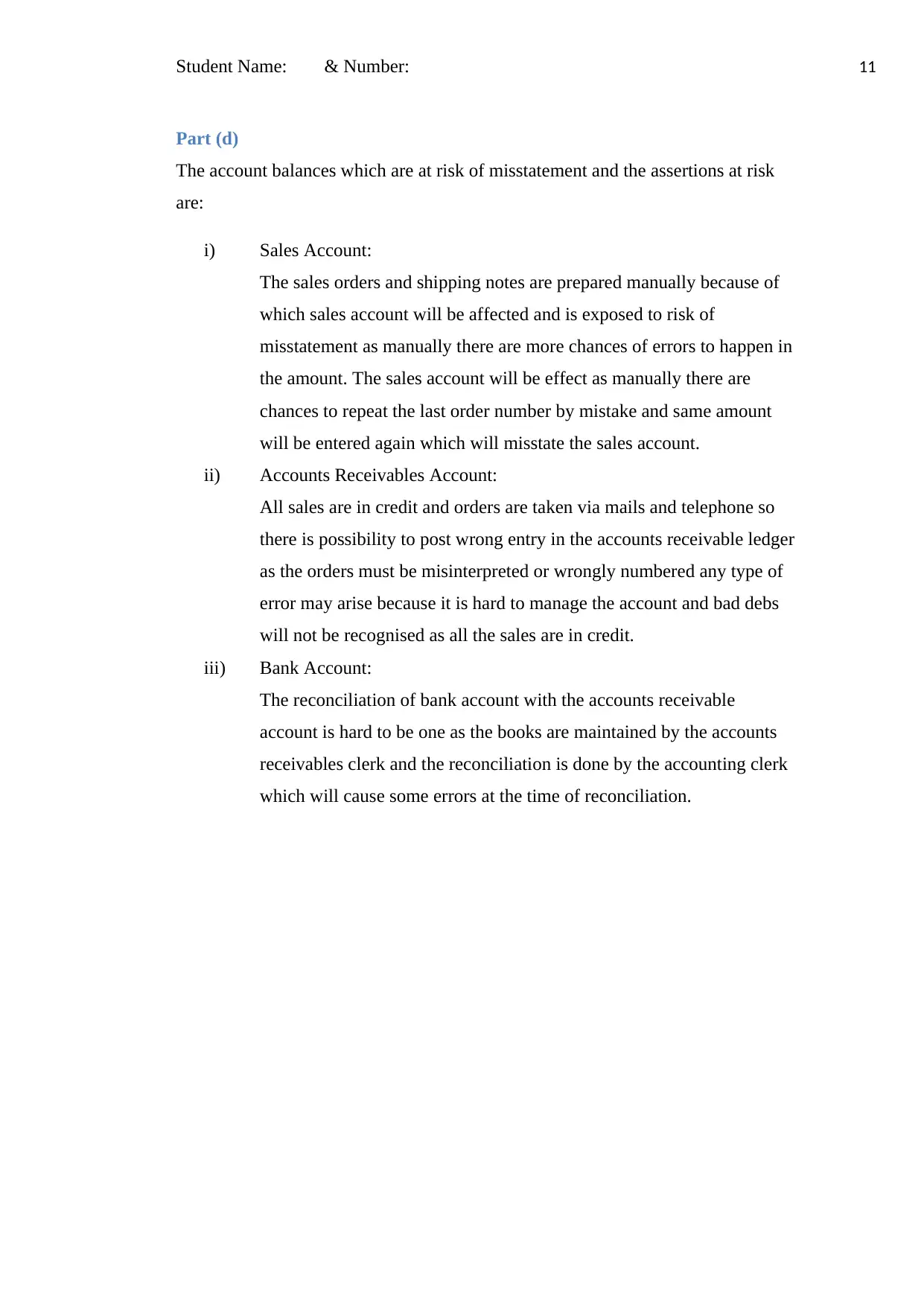
Student Name: & Number: 11
Part (d)
The account balances which are at risk of misstatement and the assertions at risk
are:
i) Sales Account:
The sales orders and shipping notes are prepared manually because of
which sales account will be affected and is exposed to risk of
misstatement as manually there are more chances of errors to happen in
the amount. The sales account will be effect as manually there are
chances to repeat the last order number by mistake and same amount
will be entered again which will misstate the sales account.
ii) Accounts Receivables Account:
All sales are in credit and orders are taken via mails and telephone so
there is possibility to post wrong entry in the accounts receivable ledger
as the orders must be misinterpreted or wrongly numbered any type of
error may arise because it is hard to manage the account and bad debs
will not be recognised as all the sales are in credit.
iii) Bank Account:
The reconciliation of bank account with the accounts receivable
account is hard to be one as the books are maintained by the accounts
receivables clerk and the reconciliation is done by the accounting clerk
which will cause some errors at the time of reconciliation.
Part (d)
The account balances which are at risk of misstatement and the assertions at risk
are:
i) Sales Account:
The sales orders and shipping notes are prepared manually because of
which sales account will be affected and is exposed to risk of
misstatement as manually there are more chances of errors to happen in
the amount. The sales account will be effect as manually there are
chances to repeat the last order number by mistake and same amount
will be entered again which will misstate the sales account.
ii) Accounts Receivables Account:
All sales are in credit and orders are taken via mails and telephone so
there is possibility to post wrong entry in the accounts receivable ledger
as the orders must be misinterpreted or wrongly numbered any type of
error may arise because it is hard to manage the account and bad debs
will not be recognised as all the sales are in credit.
iii) Bank Account:
The reconciliation of bank account with the accounts receivable
account is hard to be one as the books are maintained by the accounts
receivables clerk and the reconciliation is done by the accounting clerk
which will cause some errors at the time of reconciliation.
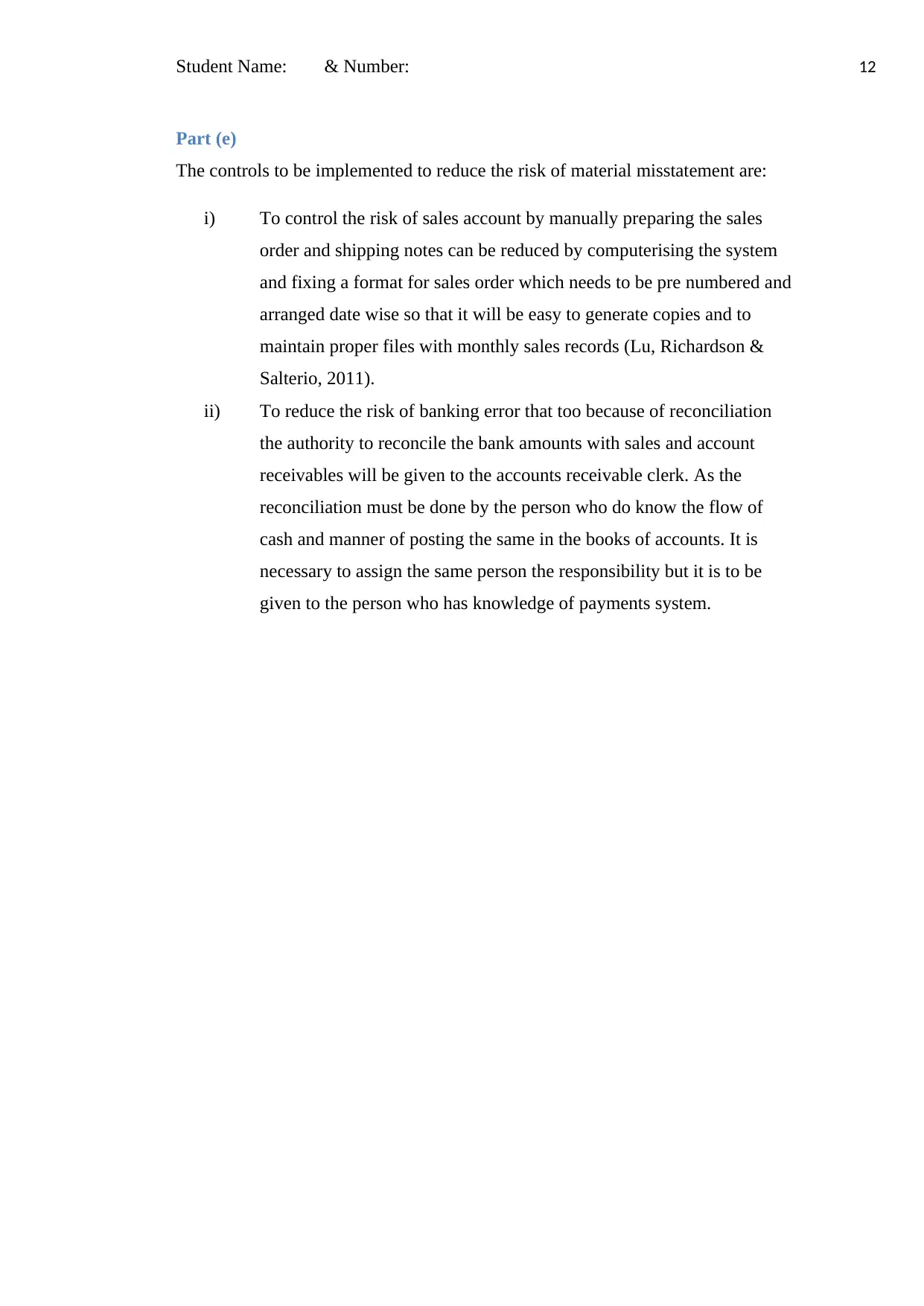
Student Name: & Number: 12
Part (e)
The controls to be implemented to reduce the risk of material misstatement are:
i) To control the risk of sales account by manually preparing the sales
order and shipping notes can be reduced by computerising the system
and fixing a format for sales order which needs to be pre numbered and
arranged date wise so that it will be easy to generate copies and to
maintain proper files with monthly sales records (Lu, Richardson &
Salterio, 2011).
ii) To reduce the risk of banking error that too because of reconciliation
the authority to reconcile the bank amounts with sales and account
receivables will be given to the accounts receivable clerk. As the
reconciliation must be done by the person who do know the flow of
cash and manner of posting the same in the books of accounts. It is
necessary to assign the same person the responsibility but it is to be
given to the person who has knowledge of payments system.
Part (e)
The controls to be implemented to reduce the risk of material misstatement are:
i) To control the risk of sales account by manually preparing the sales
order and shipping notes can be reduced by computerising the system
and fixing a format for sales order which needs to be pre numbered and
arranged date wise so that it will be easy to generate copies and to
maintain proper files with monthly sales records (Lu, Richardson &
Salterio, 2011).
ii) To reduce the risk of banking error that too because of reconciliation
the authority to reconcile the bank amounts with sales and account
receivables will be given to the accounts receivable clerk. As the
reconciliation must be done by the person who do know the flow of
cash and manner of posting the same in the books of accounts. It is
necessary to assign the same person the responsibility but it is to be
given to the person who has knowledge of payments system.
⊘ This is a preview!⊘
Do you want full access?
Subscribe today to unlock all pages.

Trusted by 1+ million students worldwide
1 out of 13
Related Documents
Your All-in-One AI-Powered Toolkit for Academic Success.
+13062052269
info@desklib.com
Available 24*7 on WhatsApp / Email
![[object Object]](/_next/static/media/star-bottom.7253800d.svg)
Unlock your academic potential
Copyright © 2020–2025 A2Z Services. All Rights Reserved. Developed and managed by ZUCOL.





